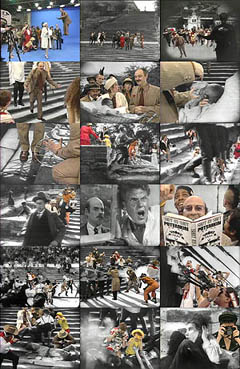- Excerpt from: Zbig Rybczynski - the Retrospective: Film & Video by Bruno Di Marino, September 2003
–In Steps everything was made live, there was no post-production. It took thirteen full days, there were numerous technical problems that I had to take into account. Many elements decided this projectęs development, but the most important for me was the experimentation with time. Technology creates a portrait, an emotion, a movement for the events. It gives them time. I was capturing the present, and this present now existed in the future. Therefore, in a sense, I was able to enter Eisensteinęs images from 1925. We can say that I was traveling back in time, collaborating with the past. I needed material that was immediately recognizable, and Eisensteinęs was perfect. The •Odessa Stepsę sequence is a rare scene, short, symbolic. It is a geometric situation, people are running, soldiers are shooting. There is drama, a beginning and an end. Steps is an example of how technology changes, it is a film about technology. I had seven film cameras, four video cameras, and an infinite numbers of cables and wires. The most interesting thing was seeing these images during filming. Thus, using this and other technologies, I was a part of the past despite the fact that the images were connected to the present.”
- Zbigniew Rybczynski, from the video by Paola Hilda Melcher, Sara Petri and Gianluca Paoletti, Zbigniew Rybczynski: Notes For an Electronic Cinema, 1999
–An arsenal of video tricks was used to create this aesthetic and political comment on modern society. Actors shot on a blue stage were keyed into the Potďmkin footage in layers, enabling them to interact with the vintage characters. In tongue-in-cheek pop art style, the piece makes a statement on the human condition and (using a sole-surviving infant as a metaphor) suggests hope for the two societies. Rybczynski and the Teletronics team used their •instant videoę technique to create Steps, something they pioneered for the Simple Minds music video also shot at Center Stage. Three hundred and fifty multi-image special effects takes were polished off in an eleven-day shoot. Using an Ultimatte unit, an Ampex Digital Optics image mover, hand-drawn holdout mattes, and a Foley man for –live sync” sound effects, taping and editing of the piece was done simultaneously, requiring only one day of post-production.”
- Paul Mandell, Video Special Effects for Steps, in –American Cinematographer December" 1987

Supersize photo

Supersize photo